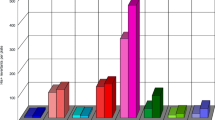Abstract
Transforming DNA exposed to either diethyl sulfate (diES) or dimethyl sulfate (diMS) is inactivated. The rate of inactivation depends on the marker tested and on the chemical used: diMS is more active than diES. Cotransformation of linked markers is similarly depressed. In contrast, there is a transient increase in the cotransformation of distant, unlinked markers. These observations indicate that some of the intermolecular complexes of transforming DNA created in the test tube by the treatment with diES and diMS are biologically active. Radioactively labeled DNA treated with diES or diMS changes its patterns of interaction with cellular surfaces that are characteristic of untreated DNA. A possibility is considered that such alterations in DNA-protein interactions as well as the ability of these alkylating agents to transpose fragments of chromosomal material may play an important role in the processes of mutagenesis and, especially, carcinogenesis.
Similar content being viewed by others
References
Anagnostopoulos, C., and Spizizen, J. (1961). Requirement for transformation in Bacillus subtilis. J. Bacteriol. 81741.
Cairns, J. (1981). The origin of human cancers. Nature 289353.
Dubnau, D. (1970). Linkage map of Bacillus subtilis. In Sober, H. A. (ed.), Handbook of Biochemistry. Selected Data for Molecular Biology, 2nd ed., Chemical Rubber Co., Cleveland, Ohio, p. I-39.
Klein, G. (1981). The role of gene dosage and genetic transpositions in carcinogenesis. Nature 194313.
Kubinski, H. (1980). Fractionation of 32P-labeled animal RNA on Sephadex-Sepharose columns. J. Chromatogr. 197236.
Kubinski, H., and Kubinski, Z. O. (1982). Further studies on the co-transformation of distant markers following the exposure of DNA to carcinogens including carcinogenic metals. Fed. Proc. 41686.
Kubinski, H., and Szybalski, E. H. (1975). Intermolecular linking and fragmentation of DNA by β-propiolactone, a monoalkylating carcinogen. Chem. Biol. Interact. 1041.
Kubinski, H., Morin, N. R., and Zeldin, P. E. (1976). Increased attachment of nucleic acids of eukaryotic and prokaryotic cells induced by chemical and physical carcinogens and mutagens. Cancer Res. 363025.
Kubinski, H., Fiandt, M., Konopa, G., and Kubinski, Z. O. (1979). Exposure of DNA to two carcinogens, dimethyl and diethylsulfate. Fed. Proc. 38502.
Kubinski, H., Gutzke, G. E., and Kubinski, Z. O. (1981a). DNA-cell binding (DCB) assay for suspected carcinogens and mutagens. Mutat. Res. 8995.
Kubinski, H., Kubinski, Z. O., Fiandt, M., and Konopa, G. (1981b). Formation of macromolecular complexes and other effects of DNA treatment with diethyl and dimethyl sulfate: Physicochemical and electronmicroscopic studies. Carcinogenesis 2981.
Kubinski, Z. O., and Kubinski, H. (1978). Alterations in Bacillus subtilis transforming DNA induced by β-propiolactone and 1,3-propane sultone, two mutagenic and carcinogenic alkylating agents. J. Bacteriol. 136854.
Lederberg, J., and Lederberg, E. M. (1952). Replica plating and indirect selection of bacterial mutants. J. Bacteriol. 63399.
Majors, J. E., Swanstrom, R., DeLorbe, W. J., Payne, G. S., Hughes, S. H., Ortiz, S., Quintrell, N., Bishop, J. M., and Varmus, H. E. (1981). DNA intermediates in the replication of retroviruses are structurally (and perhaps functionally) related to transposable elements. Cold Spring Harbor Symp. Quant. Biol. 45731.
Morin, N. R., Zeldin, P. E., Kubinski, Z. O., Bhattacharya, P. K., and Kubinski, H. (1977). Macromolecular complexes produced by chemical carcinogens and ultraviolet radiation. Cancer Res. 373802.
Noronha-Blob, L., and Pitha, J. (1979). Mechanisms of enhancement of polynucleotide binding to cells by mutagens. Biochemistry 183206.
Noronha-Blob, L., and Pitha, J. (1982). Probe for polyanionic regions on the cell surface. In Vitro 18122.
Sax, N. I. (1975). Dangerous Properties of Industrial Materials 4th ed., Van Nostrand Reinhold, New York, p. 654.
Shimotohno, K., and Temin, H. M. (1981). Evolution of retroviruses from cellular movable genetic elements. Cold Spring Harbor Symp. Quant. Biol. 45719.
Skalka, A., Ju, G., Hishinuma, F., DeBona, P. J., and Astrin, S. (1981). Structural analogies among avian retroviral DNAs and transposable elements. Cold Spring Harbor Symp. Quant. Biol. 45739.
Sutcliffe, J. G., Shinnick, T. M., and Lerner, R. A. (1981). Moloney murine leukemia virus is a transposon: nucleotide sequence analysis identifies genes and replication details. Cold Spring Harbor Symp. Quant. Biol. 45707.
Zamenhof, S., and Arikawa, S. (1970). Comparative studies on alkylation of bacterial DNA in vivo and in vitro. Mutat. Res. 9141.
Author information
Authors and Affiliations
Additional information
This work was supported in part by USPHS Grant CA-16989 and by the Consultation Practice Plan of the University of Wisconsin Medical School.
Rights and permissions
About this article
Cite this article
Kubinski, Z.O., Kubinski, H. Increased cotransformation of distant markers and altered patterns of DNA-cell interactions following the exposure of transforming DNA to two carcinogenic and mutagenic alkylating agents, diethyl and dimethyl sulfate. Biochem Genet 20, 1151–1163 (1982). https://doi.org/10.1007/BF00498939
Received:
Revised:
Issue Date:
DOI: https://doi.org/10.1007/BF00498939




